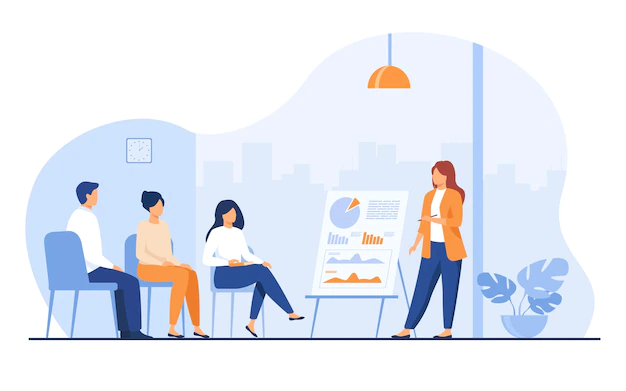Template vs Custom: Choosing A Better Approach For eLearning Software Development

Template vs custom solution might be a difficult choice to make. We have got you covered here. The field of education has changed a lot because eLearning software has been created and improved quickly. The old way of learning in a classroom is not the only option anymore. Now, there are online education platforms that can teach you a lot. In this article, we will explore the world of creating software for eLearning. We will look at the advantages, difficulties, and the technologies used to make it happen.
Also read: Custom eLearning Vendor: 4 Tips regarding their Usefulness
The Increasing Popularity of Online Learning
The internet has greatly changed education by getting rid of limitations caused by distance. E-learning means learning and studying online. It includes taking classes, using interactive programs, and attending virtual classrooms. E-learning has made it possible for people of all ages and backgrounds to access education. What makes this revolution happen? The answer is the creation of advanced eLearning software.
Advantages of eLearning Software
Accessibility means making things easy for everyone to use or access. It is about removing barriers and making sure that people with disabilities can also use and benefit from things like websites, buildings, transportation, and other services. It is important to make things accessible so that everyone can participate and be included.
- eLearning software lets you learn from anywhere and at any time, making education more convenient and flexible.
- Personalization is the act of customizing something to fit someone’s specific preferences or needs.
- These platforms can adjust the content to match each student’s needs by changing the speed and level of difficulty.
- Scalability means the ability of something to grow and handle more work or users without losing performance or efficiency.
- eLearning software can easily handle a lot of students, which helps save money for schools and universities.
- In simpler terms, interactivity means the ability to interact or communicate with something.
- Being involved and participating is important for learning to be effective. eLearning software includes fun activities like quizzes, simulations, and group chats to keep learners interested.
- Analytics refers to the process of analyzing data and information to gain insights and make informed decisions.
- Teachers can keep an eye on how students are doing and figure out where they might need more assistance. This helps them teach based on data about what students need.
Problems in Creating eLearning Software
- User Experience is about how someone feels and behaves when using a product or service. It is important to make sure the user has a positive and easy experience to keep them satisfied.
- It is important to make an interface that is easy for people to use and understand, so that they stay interested in learning. Creating something that works well for many different types of people, who may have different levels of understanding about technology, can be difficult.
- How Good is the Content? Creating valuable educational materials, such as videos, quizzes, and tests, needs knowledge and skills in teaching and technology.
- Scalability means being able to handle a growing amount of work or data, while performance refers to how well a system performs its tasks.
- As more people start using the software, it is important to make sure that it can handle a larger number of users without slowing down.
- Keeping the private information of students safe is extremely important. eLearning websites need to have strong security measures to protect information.
- Integration is a mathematical concept that combines different parts to find a total or a whole. It involves combining or merging smaller parts to create a bigger and complete picture.
- Connecting and working well with other educational tools and systems, like learning management systems, can be complicated but is necessary for a complete educational experience.
Development Approach
Development approaches are different methods or strategies that are used to plan and carry out projects or initiatives to achieve progress or growth in a particular area. These approaches can vary in complexity and focus depending on the specific goals and context of the development project.
There are many different ways to create eLearning software. Before starting a project, it is important to plan how it will be organized and decide on the most important tools to use. One thing people often talk about is whether to use templates or custom solutions.
Before you make your final decision, it is important to think about your ideas and create a plan for your product. Afterward, you can look at the market to see if there are any products that are similar. If there are projects that already have what you need, you can think about buying one that you can also change and correct. However, it is essential to ensure that you can access the code in order to make any necessary changes.
Custom Approach
It could be both the simplest and the most difficult solution at once. The reason is that it is obviously easier to start from the beginning and create something new. However, doing this will need more things and work. If you choose the custom approach, you can create a product that can be customized to meet all of your needs. For example, programmers can use different technologies and software to create things like different ways for users to interact with a website or app. They can also incorporate things like Artificial Intelligence and machine learning.
Firstly, if you select this choice, you can have a completely different result. When starting a project from nothing, there are no limits except what you can think of. Of course, this will be different while we are working because we will have to use different tools that have limits. Every programming language, framework, or library has things they are good at and things they are not so good at. However, it is up to the developer to decide which option to choose and how to design the overall structure of the future platform.
Also, because of the complete development process, the development team will always be able to use the code. This means that fixing mistakes and adding new things will be quicker and simpler. It also allows you to handle and create your own parts and add them to the system later.
On the other hand, if you want to create a special and good product, you will need many materials and tools. First, you need a skilled team of developers who can handle and create a project, especially if it is a big one. As a result, you will need to save more money. Furthermore, starting from the beginning takes longer because it involves creating the code parts, testing them, and running them.
Templates Solution
Templates are a solution that offers pre-designed formats or patterns for various purposes. These templates provide a convenient and efficient way to create or present something. They simplify the process by providing a structure that can be customized according to individual needs. Templates are often used in design, writing, and other creative fields to streamline the creation process and ensure consistent results.
Instead of creating something from scratch, you can use a pre-made template instead. As previously mentioned, you need to form your idea and plan how the future platform will be organized. It is possible that the main parts can be included in an existing platform. If this happens, you just have to find one and make a few changes.
There are many products available that come with the basic features and can be changed or improved to fit the customer’s preferences. In addition, there are also website builders like WordPress that allow anyone to make their own website or even web application. However, this method is not as flexible as the individual one.
Templates are like widgets or plug-ins. They are pre-made components that have one specific feature. They are separate elements that can work on their own. Moreover, templates are like basic shapes that can be easily modified or remade to suit different needs. Therefore, the user can put different templates together in one system without worrying that they will affect each other.
However, there are still restrictions when it comes to using templates. Usually, the changes that can be made are not very important. Actually, templates are made to be a ready-to-use part that has its own purpose or characteristic. So, you need to find a specific template that matches the tasks you have to do. To put it simply, you can’t change it however you want.
This is the other side of using templates. On one side, they let you personalize and offer different abilities. At the same time, they cannot be greatly altered because they are already finished. So, most of the changes are just about how things look, instead of how they work.
Deciding Between Template vs Custom
Template or not to choose a template. Custom means something that is made or done specifically for a particular person or purpose. It is not something that is the same for everyone, but rather unique and tailored to fit individual needs or preferences. Customization allows for personalization and the ability to have something just the way you want it.
In simple terms, this question is not easy. It is reasonable to say that all approaches can be good options, but the outcome ultimately depends on the developer and not the approach they choose. However, when discussing the choice between these solutions, it is possible to identify the situations in which it is best to choose each one.
For example, templates are a good option when you have limited resources, such as not much money or time. They make it easier to develop. In addition, they can be helpful when things change quickly, like if your platform is often updated or connected to different events. Templates help you make different types of pages quickly.
Templates are a good option if you want a simple and easy way to create a basic platform with common features. They are clearly less expensive than starting from the beginning. Additionally, utilizing a template does not necessitate advanced development abilities. Simply put, most of them can be used even without knowing how to program. Templates are frequently able to perform their intended tasks without any human intervention. As we said earlier, they are already built structures that can be used as they are, but you can make small changes to their appearance.
You can compare templates to Lego sets: there are different ready-made pieces, and customers can put these pieces together however they want, but they also have to follow certain rules. For example, you cannot alter the form of the components, but you can discover the ones that are most suitable for you. At the same time, custom solutions are more like clay: you have unlimited freedom to change its shape as you wish. However, if you want to create a product that looks good, you will need to spend more time and have more skill.
Clearly, the custom approach can be tailored to fit almost any need or preference. This tool lets you add any features and functions, but you need a skilled team and plenty of resources to make them work. Even if it is more difficult, it can still be done to improve or modify the entire structure. If you want to create a new or big product, it is better to use customized solutions. Also, it is the only answer if there are no ready-made designs.
In the end, it is impossible to say exactly what makes each choice the best one. The best way to do things is to plan the project first before making any decisions based on the final product.







